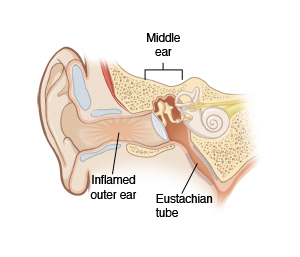Your child has an infection in the ear canal. This problem is also known as external otitis, otitis externa, or "swimmer’s ear." It is usually caused by bacteria or fungus. It can occur if water is trapped in the ear canal (from swimming or bathing). Putting cotton swabs or other objects in the ear can also damage the skin in the ear canal and make this problem more likely.
Your child may have pain, itching, redness, drainage, or swelling of the ear canal. They may also have temporary hearing loss. In most cases, symptoms resolve within a week.
Home care
Follow these guidelines when caring for your child at home:
-
Don’t try to clean the ear canal. This may push pus and bacteria deeper into the canal.
-
Use prescribed eardrops as directed. These help reduce swelling and fight the infection. If an ear wick was placed in the ear canal, apply drops right onto the end of the wick. The wick will draw the medicine into the ear canal even if it is swollen closed.
-
A cotton ball may be loosely placed in the outer ear to absorb any drainage.
-
Don’t allow water to get into your child’s ear when they are bathing. Also, don’t allow your child to go swimming for at least 7 to10 days after starting treatment.
-
You may give your child acetaminophen to control pain, unless another pain medicine was prescribed. In children older than 6 months, you may use ibuprofen instead of acetaminophen. If your child has chronic liver or kidney disease, talk with the provider before using these medicines. Also talk with the provider if your child has had a stomach ulcer or gastrointestinal bleeding. Don’t give aspirin to a child younger than 18 years old without first talking with the healthcare provider. It may cause severe liver damage.
Don't give your child any other medicine without first asking your child's healthcare provider, especially for the first time. Discuss any questions about an over-the-counter medicine or its side effects with your child's healthcare provider or pharmacist before giving the medicine to your child.
Prevention
-
Don’t clean the inside of your child’s ears. Also, caution your child not to stick objects inside their ears.
-
Have your child wear earplugs when swimming.
-
After exiting water, have your child turn their head to the side to drain any excess water from the ears. Ears should be dried well with a towel. A hair dryer may be used to dry the ears, but it needs to be on a low or cool setting and about 12 inches away from the ears.
-
If your child feels water trapped in the ears, use ear drops right away. You can get these drops over the counter at most drugstores. They work by removing water from the ear canal.
Follow-up care
Follow up with your child’s healthcare provider, or as directed.
When to seek medical advice
Call your child's healthcare provider right away if any of these occur:
-
Fever (see Fever and children, below)
-
Symptoms worsen or do not get better after 3 days of treatment
-
New symptoms appear
-
Outer ear becomes red, warm, or swollen
-
Drainage from the ear
Fever and children
Use a digital thermometer to check your child’s temperature. Don’t use a mercury thermometer. There are different kinds and uses of digital thermometers. They include:
-
Rectal. For children younger than 3 years, a rectal temperature is the most accurate.
-
Forehead (temporal). This works for children age 3 months and older. If a child under 3 months old has signs of illness, this can be used for a first pass. The provider may want to confirm with a rectal temperature.
-
Ear (tympanic). Ear temperatures are accurate after 6 months of age, but not before.
-
Armpit (axillary). This is the least reliable but may be used for a first pass to check a child of any age with signs of illness. The provider may want to confirm with a rectal temperature.
-
Mouth (oral). Don’t use a thermometer in your child’s mouth until they are at least 4 years old.
Use a rectal thermometer with care. Follow the product maker’s directions for correct use. Insert it gently. Label it and make sure it’s not used in the mouth. It may pass on germs from the stool. If you don’t feel OK using a rectal thermometer, ask the healthcare provider what type to use instead. When you talk with any healthcare provider about your child’s fever, tell them which type you used.
Below is when to call the healthcare provider if your child has a fever. Your child’s healthcare provider may give you different numbers. Follow their instructions.
When to call a healthcare provider about your child’s fever
For a baby under 3 months old:
-
First, ask your child’s healthcare provider how you should take the temperature.
-
Rectal or forehead: 100.4°F (38°C) or higher
-
Armpit: 99°F (37.2°C) or higher
-
A fever of ___________as advised by the provider
For a child age 3 months to 36 months (3 years):
-
Rectal or forehead: 102°F (38.9°C) or higher
-
Ear (only for use over age 6 months): 102°F (38.9°C) or higher
-
A fever of ___________ as advised by the provider
In these cases:
-
Armpit temperature of 103°F (39.4°C) or higher in a child of any age
-
Temperature of 104°F (40°C) or higher in a child of any age
-
A fever of ___________ as advised by the provider


